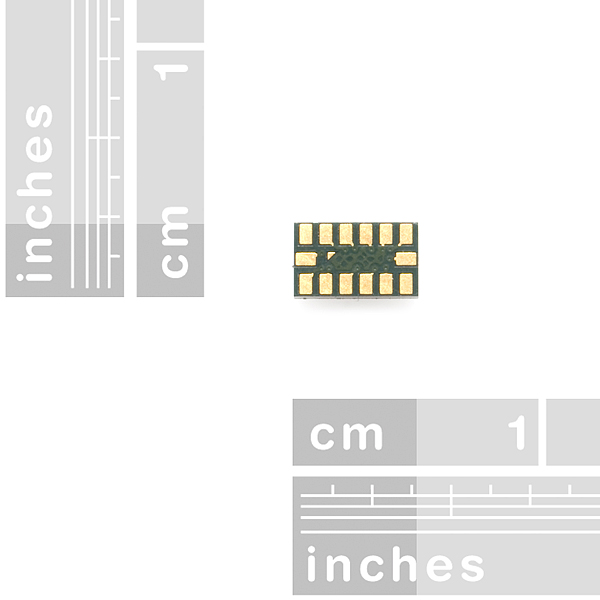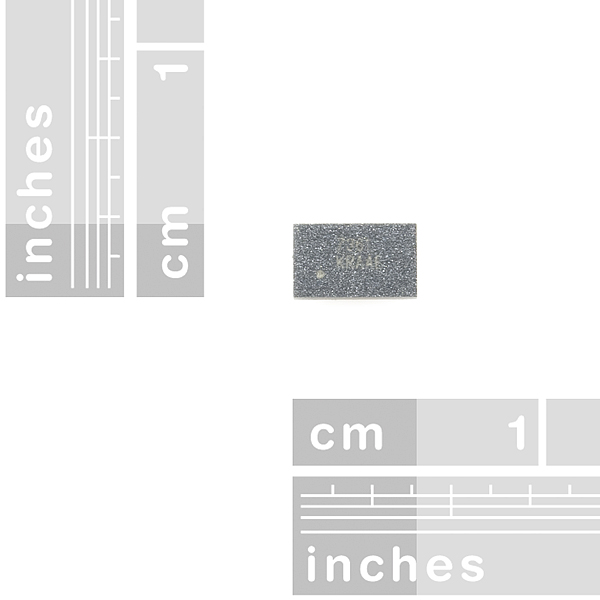Triple-Axis Accelerometer - MMA7361L
Replacement: None. We are no longer carrying this Triple-Axis Accelerometer in our catalog. This page is for reference only.
The MMA7361LR1 is a low power, three-axis analog MEMS accelerometer. The sensor has a g-Select input which allows for the selection between two measuring ranges - ±1.5g or ±6g.
Other features include signal conditioning, a 1-pole low pass filter, temperature compensation, self test, and 0g-detect which detects linear freefall. Zero-g offset and sensitivity are factory set and require no external devices. The MMA7361L also includes a sleep mode.
The sensor works on power between 2.2 and 3.6VDC (3.3V optimal), and typically consumes just 400µA of current. All three axes have their own analog output.
- Two selectable measuring ranges (±1.5g, ±6g)
- Low current consumption: 400 µA
- Sleep mode: 3 µA
- Low voltage operation: 2.2 V - 3.6 V
- High sensitivity (800 mV/g at 1.5g)
- Fast turn on time (0.5 ms enable response time)
- Self test for freefall detect diagnosis
- 0g-Detect for freefall protection
- Signal conditioning with low pass filter
- Robust design, high shocks survivability
- RoHS compliant
- Environmentally preferred product
- Low cost
- 3.0 x 5.0 x 1.0 mm (LGA-14-pin package)
- Datasheet
- Freescale Product Page (more application notes, etc.)
Triple-Axis Accelerometer - MMA7361L Product Help and Resources
Core Skill: Soldering
This skill defines how difficult the soldering is on a particular product. It might be a couple simple solder joints, or require special reflow tools.
Skill Level: Competent - You will encounter surface mount components and basic SMD soldering techniques are required.
See all skill levels
Core Skill: Programming
If a board needs code or communicates somehow, you're going to need to know how to program or interface with it. The programming skill is all about communication and code.
Skill Level: Competent - The toolchain for programming is a bit more complex and will examples may not be explicitly provided for you. You will be required to have a fundamental knowledge of programming and be required to provide your own code. You may need to modify existing libraries or code to work with your specific hardware. Sensor and hardware interfaces will be SPI or I2C.
See all skill levels
Core Skill: Electrical Prototyping
If it requires power, you need to know how much, what all the pins do, and how to hook it up. You may need to reference datasheets, schematics, and know the ins and outs of electronics.
Skill Level: Competent - You will be required to reference a datasheet or schematic to know how to use a component. Your knowledge of a datasheet will only require basic features like power requirements, pinouts, or communications type. Also, you may need a power supply that?s greater than 12V or more than 1A worth of current.
See all skill levels
Comments
Looking for answers to technical questions?
We welcome your comments and suggestions below. However, if you are looking for solutions to technical questions please see our Technical Assistance page.
Customer Reviews
No reviews yet.




Hey.... Can i solder this on PCB?? and at which temperature???
If you're careful, you can solder it by hand, at standard temperatures. (Like any other part, you can avoid overheating it by soldering one lead at a time and letting it cool a bit between).
You might also consider purchasing it already mounted on a breakout board (in the related products below), and mounting the breakout to your PCB, which would be an easier soldering job.
Thank You!!! Yaa.... I know about breakout board..but actually the matter is i have 2 acce. of this type!! In future, i will purchase breakout only... and i asked this because product can sustain upto 70C or 80C only..and normal soldering temp. is about 200*C!! So....
Guys,
I can not make it work properly.
In 6g configuration, it seems the temperature compensation does not do its job, and simply when I blow on it, the output drops from 2000lsb (12 bits ADC) to 1800lsbn which is 10% or nearly 1g !
In the spec, it is written 0.5mg/?C biais stability.
Clearly I never saw this.
However, mechanic stress does not affect the output, which is good news.
Has anybody been able to make it work properly ?
Antoine
Any update on the breakout board?
Thx
check the related products, should be restocked soon
Hi
When is the promised breakout board coming?
Cheers.